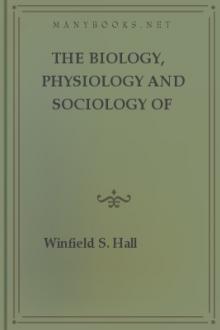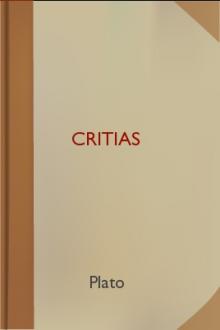Illusions, James Sully [speld decodable readers .TXT] 📗

- Author: James Sully
- Performer: -
Book online «Illusions, James Sully [speld decodable readers .TXT] 📗». Author James Sully
The Project Gutenberg EBook of Illusions, by James Sully
This eBook is for the use of anyone anywhere at no cost and with
almost no restrictions whatsoever. You may copy it, give it away or
re-use it under the terms of the Project Gutenberg License included
with this eBook or online at www.gutenberg.org
Title: Illusions
A Psychological Study
Author: James Sully
Release Date: February 21, 2006 [EBook #17815]
Language: English
*** START OF THIS PROJECT GUTENBERG EBOOK ILLUSIONS ***
Produced by Thierry Alberto, Janet Blenkinship and the
Online Distributed Proofreaders Europe at
http://dp.rastko.net
ILLUSIONS A PSYCHOLOGICAL STUDY BY JAMES SULLY
AUTHOR OF "SENSATION AND INTUITION," "PESSIMISM," ETC.
THIRD EDITIONLONDON
KEGAN PAUL, TRENCH & CO., 1, PATERNOSTER SQUARE
1887
(The rights of translation and of reproduction are reserved)
THE INTERNATIONAL SCIENTIFIC SERIES. VOL. XXXIV. PREFACE.The present volume takes a wide survey of the field of error, embracing in its view not only the illusions of sense dealt with in treatises on physiological optics, etc., but also other errors familiarly known as illusions, and resembling the former in their structure and mode of origin. I have throughout endeavoured to keep to a strictly scientific treatment, that is to say, the description and classification of acknowledged errors, and the explanation of these by a reference to their psychical and physical conditions. At the same time, I was not able, at the close of my exposition, to avoid pointing out how the psychology leads on to the philosophy of the subject. Some of the chapters were first roughly sketched out in articles published in magazines and reviews; but these have been not only greatly enlarged, but, to a considerable extent, rewritten.
J. S.
Hampstead, April, 1881.
CONTENTS.CHAPTER I.
THE STUDY OF ILLUSION.
Vulgar idea of Illusion, 1, 2; Psychological treatment of subject, 3, 4;
definition of Illusion, 4-7; Philosophic extension of idea, 7, 8.
CHAPTER II.
THE CLASSIFICATION OF ILLUSIONS.
Popular and Scientific conceptions of Mind, 9, 10; Illusion and
Hallucination, 11-13; varieties of Immediate Knowledge, 13-16; four-fold
division of Illusions, 16-18.
CHAPTER III.
ILLUSIONS OF PERCEPTION: GENERAL.
Psychology of Perception:—The Psychological analysis of Perception, 19,
20; Sensation and its discrimination, etc., 20, 21; interpretation of
Sensation, 22, 23; construction of material object, 23, 24; recognition
of object, specific and individual, 24-27; Preperception and
Perception, 27-31; Physiological conditions of Perception, 31-33;
Visual and other Sense-perception, 33, 34.
Illusions of Perception:—Illusion of Perception defined, 35-38; sources
of Sense-illusion, 38-40: (a) confusion of Sense-impression, 40-44;
(b) misinterpretation of Sense-impression, 44; Passive and Active
misinterpretation, 44-46; Passive Illusions as organically and
extra-organically conditioned, 46-49.
CHAPTER IV.
ILLUSIONS OF PERCEPTION—continued.
A. Passive Illusions (a) as determined by the Organism.
Results of Limits of Sensibility:—Relation of quantity of Sensation to
that of Stimulus, 50-52; coalescence of simultaneous Sensations,
52-55; after-effect of Stimulation, 55, 56; effects of prolonged
Stimulation, 56-58; Specific Energy of Nerves, 58, 59; localization
of Sensation, 59-62; Subjective Sensations, 62-64.
Results of Variation of Sensibility:—Rise and fall of Sensibility, 64-67;
Paræsesthesia, 67, 68; rationale of organically conditioned Illusions,
68, 69.
CHAPTER V.
ILLUSIONS OF PERCEPTION—continued.
A. Passive Illusions (b) as determined by the Environment.
Exceptional Relation of Stimulus to Organ:—Displacement of organ, etc.,
70-72.
Exceptional Arrangement of Circumstances in the Environment:—Misinterpretation
of the direction and movement of objects, 72-75;
misperception of Distance, 75, 76; Illusions of depth, relief, and
solidity in Art, 77-81; Illusions connected with the perception of
objects through transparent coloured media, 82-84; visual transformation
of concave into convex form, 84-86; false recognition of
objects, 86, 87; inattention to Sense-impression in Recognition,
87-91; suggestion taking the direction of familiar recurring experiences,
91, 92.
CHAPTER VI.
ILLUSIONS OF PERCEPTION—continued.
B. Active Illusions.
Preperception and Illusion, 93-95.
Voluntary Preperception:—Choice of interpretation in the case of visible
movement, 95, 96; and in the case of flat projections of form,
96-98; capricious interpretation of obscure impressions, 99, 100.
Involuntary Preperception:—Effects of permanent Predisposition, 101, 102;
effects of partial temporary Preadjustment, 102-105; complete Pro-adjustment
or Expectation, 106-109; subordination of Sense-impression
to Preperception, 109-111; transition from Illusion to Hallucination,
111, 112; rudimentary Hallucinations, 112-114; developed
Hallucinations, 114-116; Hallucination in normal life, 116, 117;
Hallucinations of insanity, 118-120; gradual development of Sense-illusions,
and continuity of normal and abnormal life; 120-123;
Sanity and Insanity distinguished, 123-126.
CHAPTER VII.
DREAMS.
Mystery of sleep, 127, 128; theories of Dreams, 128, 129; scientific
explanation of Dreams, 129, 130.
Sleep and Dreaming:—Condition of organism during sleep, 131, 132;
Are the nervous centres ever wholly inactive during sleep? 132-134;
nature of cerebral activity involved in Dreams, 134-136; psychical
conditions of Dreams, 136-138.
The Dream as Illusion:—External Sense-impressions as excitants of
Dream-images, 139-143; internal "subjective" stimuli in the sense-organs,
143-145; organic sensations, 145-147; how sensations are
exaggerated in Dream-interpretation, 147-151.
The Dream as Hallucination:—Results of direct central stimulation
151-153; indirect central stimulation and association, 153-155.
The Form and Structure of Dreams:—The incoherence of Dreams explained,
156-161; coherence and unity of Dream as effected (a) by
coalescence and transformation of images, 161-163; (b) by aground-tone
of feeling, 164-168; (c) by the play of associative dispositions,
168-172; (d) by the activities of selective attention stimulated by
the rational impulse to connect and to arrange, 172-176; examples
of Dreams, 176-179; limits of intelligence and rational activity in
Dreams, 180-182; Dreaming and mental disease, 182, 183; After-dreams
and Apparitions, 183-185.
NOTE.—The Hypnotic Condition, 185-188.
CHAPTER VIII.
ILLUSIONS OF INTROSPECTION.
Illusions of Introspection defined, 189-192; question of the possibility
of illusory Introspection, 192-194; incomplete grasp of internal
feelings as such, 194-196; misobservation of internal feelings: Passive
Illusions, 196-199; Active Illusions, 199-202; malobservation of
subjective states, 202-205; Illusory Introspection in psychology and
philosophy, 205-208; value of the Introspective method, 208-211.
CHAPTER IX.
OTHER QUASI-PRESENTATIVE ILLUSIONS: ERRORS OF INSIGHT.
Emotion and Perception, 212; Æsthetic Intuition, 213; Subjective Impressions
of beauty misinterpreted, 213-216; analogous Emotional
Intuitions, 216, 217; Insight, its nature, 217-220; Passive Illusions
of Insight, 220-222; Active Illusions of Insight: projection of individual
feelings, 222-224; the poetic transformation of nature, 224-226;
special predispositions as falsifying Insight, 226-228; value of
faculty of Insight, 228-230.
CHAPTER X.
ILLUSIONS OF MEMORY.
Vulgar confidence in Memory, 231-233; definition of Memory, 233-235;
Psychology of Memory, 235-237; Physiology of Memory, 237, 238;
Memory as localization in the past, 238-241; Illusions of Memory
classified, 241-245.
(1) Illusions of Time-Perspective:—
(a) Definite Localization of events: constant errors in retrospective
estimate of time, 245-249; varying errors: estimate of duration
during a period, 249-251; variations in retrospective estimate of
duration, 251-256.
(b) Indefinite Localization: effect of vividness of mnemonic image
on the apparent distance of events, 256-258; isolated public events,
258, 259; active element in errors of Localization, 259-261.
(2) Distortions of Memory:—Transformation of past through forgetfulness,
261-264; confusion of distinct recollections, 264-266; Active
Illusion: influence of present imaginative activity, 266-269; exaggeration
in recollections of remote experiences, 269, 270; action of
present feeling in transforming past, 270, 271.
(3) Hallucinations of Memory:—Their nature, 271-273; past dreams taken
for external experiences, 273-277; past waking imagination taken
for external reality, 277-280; recollection of prenatal ancestral
experience, 280, 281; filling up gaps in recollection, 281-283.
Illusions connected with, Personal Identity:—Illusions of Memory and
Sense of identity, 283, 284; idea of permanent self, how built up,
285-287; disturbances of sense of identity, 287-290; fallibility and
trustworthiness of Memory, 290-292.
NOTE.—Momentary Illusions of Self-consciousness, 293.
CHAPTER XI.
ILLUSIONS OF BELIEF.
Belief as Immediate or Intuitive, 294-296; simple and compound Belief, 296.
A. Simple Illusory Belief:—
(1) Expectation: its nature, 297, 298; Is Expectation ever intuitive?
298; Expectation and Inference from the past, 299-301; Expectation
of new kinds of experience, 301, 302; Permanent Expectations
of remote events, 302; misrepresentation of future duration,
302-305; Imaginative transformation of future, 305-307.
(2) Quasi-Expectations: anticipation of extra-personal experiences,
307, 308; Retrospective Beliefs, 308-312.
B. Compound Illusory Belief:—
(1) Representations of permanent things: their structure, 312; our
representations of others as illusory, 312-315; our





Comments (0)